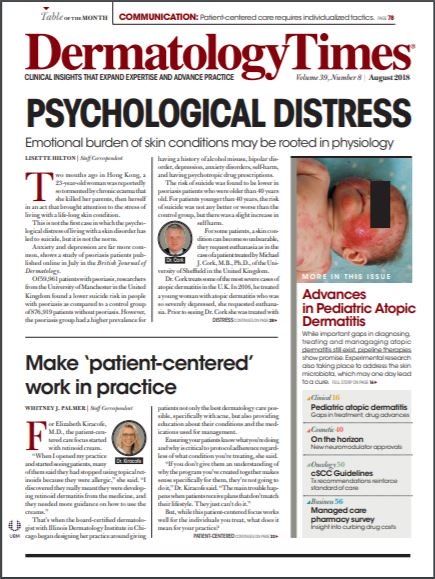- Case-Based Roundtable
- General Dermatology
- Eczema
- Chronic Hand Eczema
- Alopecia
- Aesthetics
- Vitiligo
- COVID-19
- Actinic Keratosis
- Precision Medicine and Biologics
- Rare Disease
- Wound Care
- Rosacea
- Psoriasis
- Psoriatic Arthritis
- Atopic Dermatitis
- Melasma
- NP and PA
- Skin Cancer
- Hidradenitis Suppurativa
- Drug Watch
- Pigmentary Disorders
- Acne
- Pediatric Dermatology
- Practice Management
- Prurigo Nodularis
- Buy-and-Bill
Publication
Article
Dermatology Times
Language used in medical records can stigmatize patients for years
Author(s):
A Johns Hopkins study finds that physicians who use stigmatizing language in their patients' medical records, may actually be hurting the care those patients get for years to come.
A Johns Hopkins study finds that physicians who use stigmatizing language in their patients' medical records, may actually be hurting the care those patients get for years to come.
When doctors read notes and descriptions from previous medical visits, says the study, published in the May issue of The Journal of General Internal Medicine, the language in those notes may play a role in how that patient is treated, as well as how aggressively the patient's pain is managed.
Mary Catherine Beach, M.D., M.P.H., designed the study to determine whether the language and descriptions used in patient records can perpetuate bias among physicians. More than 400 physicians-in-training -- medical students and residents -- were presented with one of two vignettes about a hypothetical patient, a 28-year-old man with sickle cell disease and chronic hip pain.
While the vignettes contained medically identical information, one used neutral language to describe the patient and his condition, while the other vignette contained nonessential language that implied various value judgements.
Dr. Beach and her research colleagues found that physicians-in-training who read the stigmatizing patient chart notes were significantly more likely to have a negative attitude toward the patient than those who read the chart containing more neutral language.
And not only did their attitudes changeâ so did their treatment plans. Those physicians-in-training who had read the stigmatizing chart note decided to treat the patient's pain less aggressively.
Every clinician encounter with a patient is documented in a chart note. Symptoms, patient history, vital signs, test results, clinicians' assessments and treatment plans are all part of the medical record.
"This record may be the only source of information a new clinician has about some patients," says Dr. Beach. "We have to question the assumption that the medical record always represents an objective space."
In one patient-doctor encounter cited in the study, study participants were presented with a wheelchair bound patient. The patient was described differently in every encounter from “pain is not alleviated by his home pain medication regimen" to “He is narcotic dependent and in our ED frequently."
"There is growing evidence that the language used to communicate in health care reflects and influences clinician attitudes toward their patients," says Anna Goddu, a Johns Hopkins University School of Medicine student who co-authored the study. "Medical records are an important and overlooked pathway by which bias may be propagated from one clinician to another, further entrenching health care disparities."







